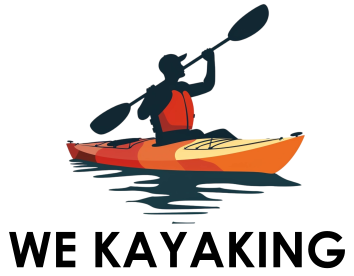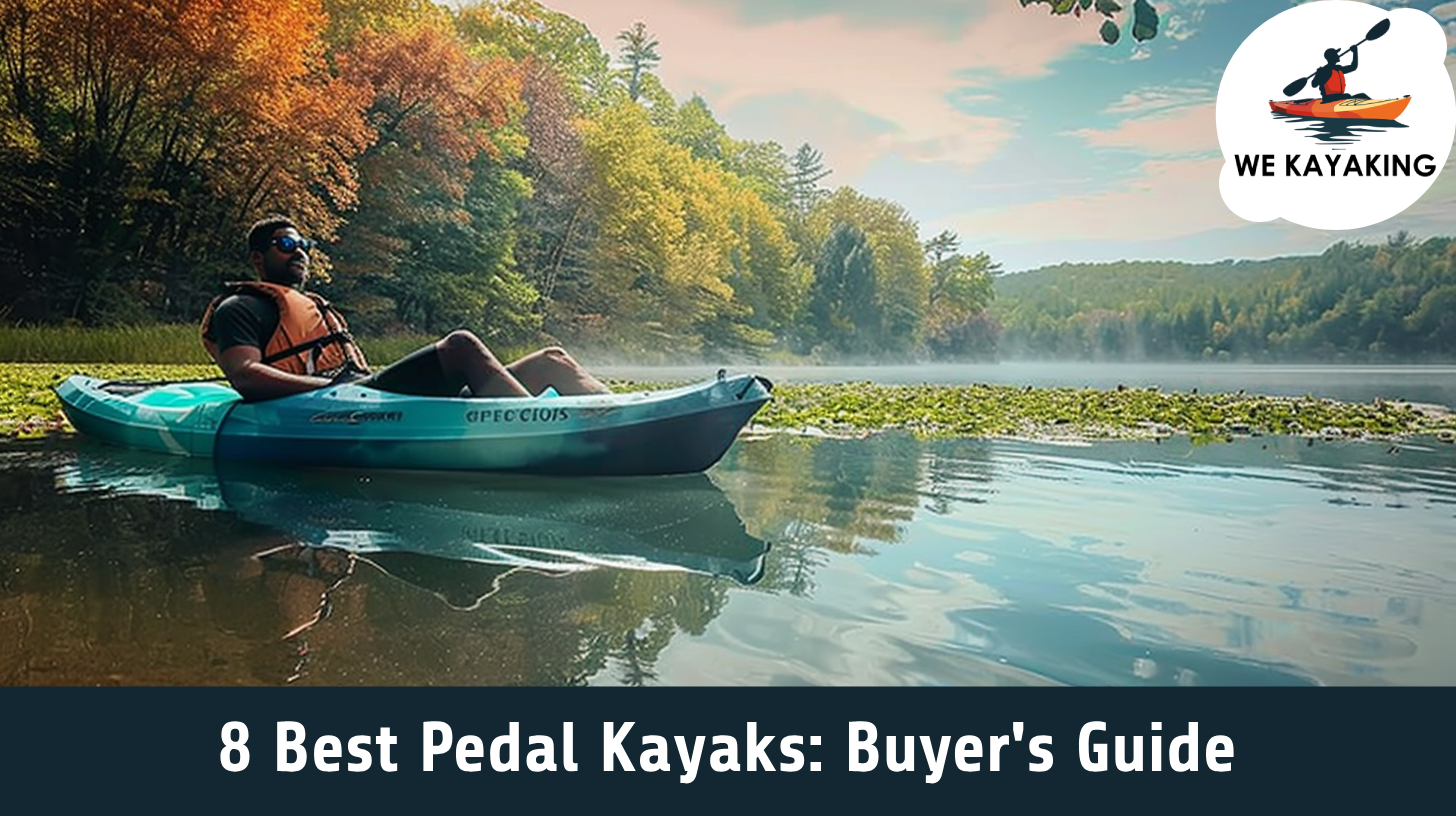
8 Best Pedal Kayaks: Buyer's Guide
Pedal kayaks are a game-changer in the world of kayaking, blending the traditional appeal of kayaking with the innovation of pedal-driven movement. These kayaks are propelled by a pedal system, allowing users to navigate the waters using their legs, which is particularly advantageous for those looking to keep their hands free for activities like fishing, photography, or bird watching. The pedal mechanism not only enhances the kayak’s maneuverability but also boosts its stability, making it a popular choice among enthusiasts.
In evaluating the 8 best pedal kayaks, it’s essential to consider a range of criteria that directly impact the user experience. Performance and speed are paramount, as they determine the kayak’s efficiency in cutting through water. Stability and comfort are also crucial, ensuring a secure and enjoyable journey, particularly during extended use. The kayak’s durability and construction dictate its longevity and resilience against diverse aquatic environments. The efficiency of the pedal system itself is a critical factor, as it influences the ease of movement and control.
Additionally, the weight and portability of the kayak affect its convenience, especially for those who embark on solo trips. Storage capacity and the kayak bear’s overall load are important for adventurers who carry gear for fishing or camping. Price points and the value offered by each kayak play a major role in the decision-making process, balancing affordability with quality and features. Lastly, user reviews and the reputation of each model provide real-world insights, guiding potential buyers towards the most reliable and satisfactory choices.
Table of Contents
1. Perception Crank 10
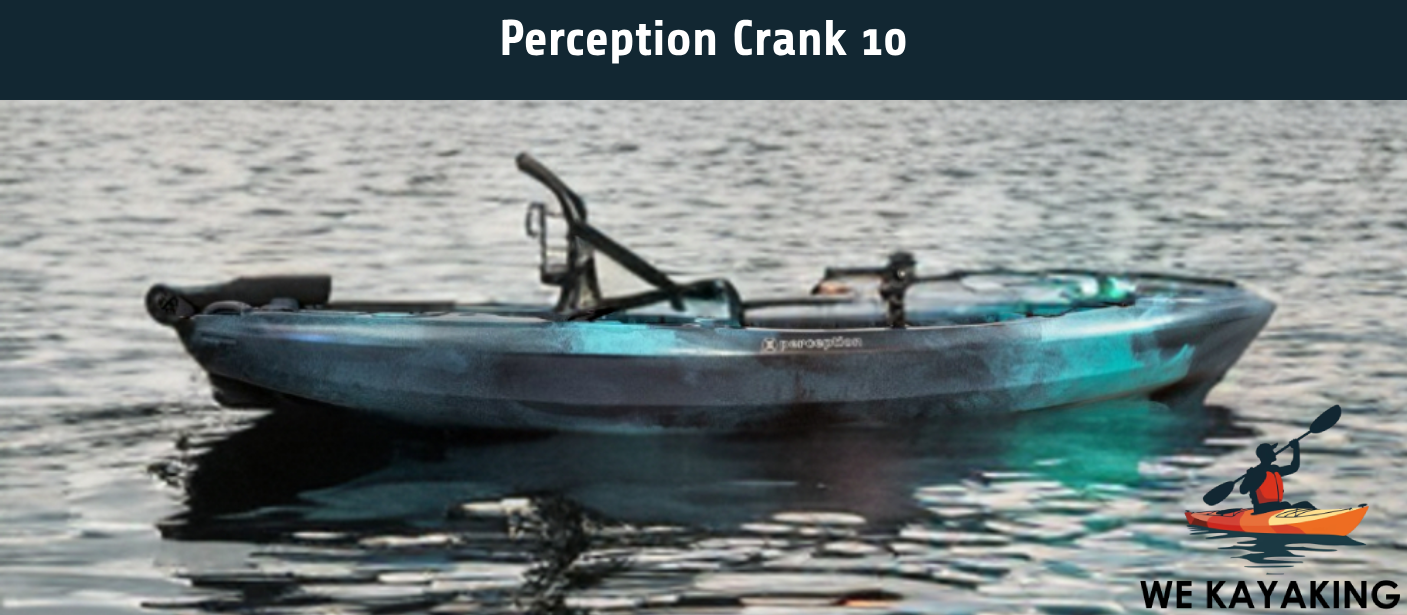 The Perception Crank 10 is a versatile and compact pedal-driven kayak designed for a variety of water conditions. It features a rotational pedal system that mimics the motion of cycling, allowing for efficient propulsion and hands-free navigation. This kayak is known for its excellent tracking ability, maintaining a straight course even in challenging conditions. Stability is a hallmark of the Crank 10, providing confidence to kayakers in various activities, from fishing to leisure paddling. Its speed is commendable for a 10-foot kayak, making it agile and fun to use. With a length of 10 feet and a width of 35 inches, it strikes a balance between maneuverability and stability.
The Perception Crank 10 is a versatile and compact pedal-driven kayak designed for a variety of water conditions. It features a rotational pedal system that mimics the motion of cycling, allowing for efficient propulsion and hands-free navigation. This kayak is known for its excellent tracking ability, maintaining a straight course even in challenging conditions. Stability is a hallmark of the Crank 10, providing confidence to kayakers in various activities, from fishing to leisure paddling. Its speed is commendable for a 10-foot kayak, making it agile and fun to use. With a length of 10 feet and a width of 35 inches, it strikes a balance between maneuverability and stability.
The kayak’s manageable weight of approximately 87 pounds facilitates transport and handling. Comfort is prioritized with an adjustable and ergonomically designed seat, ensuring enjoyable long-duration outings. Durability is ensured through high-quality polyethylene construction, which is resistant to impact and wear. The material also contributes to the kayak’s safety, along with its stable design and buoyancy. Extra storage options are integrated, catering to the needs of anglers and explorers alike. Perception Kayaks, the brand behind the Crank 10, is recognized for its reliable and innovative products. The price reflects the kayak’s quality and features, positioning it as a mid-range option in the pedal kayak market.
Advantages of Perception Crank 10 are listed below.
- The Crank 10’s rotational pedal system mirrors a bicycling motion, providing an intuitive and efficient means of propulsion. This hands-free operation is especially beneficial for those who want to fish or take photos, as it allows for multitasking.
- The kayak’s design ensures superior tracking, keeping it on a straight course even in challenging conditions. Its wide build contributes to exceptional stability, making it a safe and reassuring choice for both novices and seasoned kayakers.
- Despite its stability, the Crank 10 doesn’t compromise on speed. Its compact 10-foot length makes it nimble and enjoyable to paddle, making it suitable for a variety of water conditions.
- The adjustable, ergonomically designed seat supports long-duration outings, ensuring kayakers remain comfortable throughout their journey.
- Constructed from high-quality polyethylene, the Crank 10 is built to last, capable of withstanding the usual wear and tear associated with kayaking activities.
- With ample storage options, the Crank 10 caters to the needs of anglers and explorers, providing space for gear, snacks, and other essentials.
Disadvantages of Perception Crank 10 are listed below.
- While the Crank 10 offers good speed for its size, it is not be the best option for those looking to cover longer distances quickly. Its compact design, which benefits maneuverability and stability, limits its overall speed and efficiency during extended paddles in open water.
- For those new to pedal kayaks, there is a learning curve associated with mastering the rotational pedal system. Although intuitive for many, it requires a different skill set and physical effort compared to traditional paddling, which do not suit everyone’s preferences or abilities.
- While the Crank 10 is praised for its storage capabilities, the compact design limits the amount and size of gear that is brought along, especially for those planning more gear-intensive activities like camping or long fishing trips.
- Pedal kayaks, in general, require more maintenance than their paddle counterparts due to the complexity of their pedal systems. Regular cleaning, lubrication, and checks are necessary to keep the system functioning smoothly, which could be a drawback for those seeking low-maintenance watercraft.
| Feature | Details |
| Weight Capacity | 350 lbs/158.7 kgs |
| Kayaker Position | On Top (sit-on-top) |
| Amount of Riders | Solo |
| Body Type | Accommodates a wide range with adjustable seating and pedal system |
2. Perception Showdown 11.5
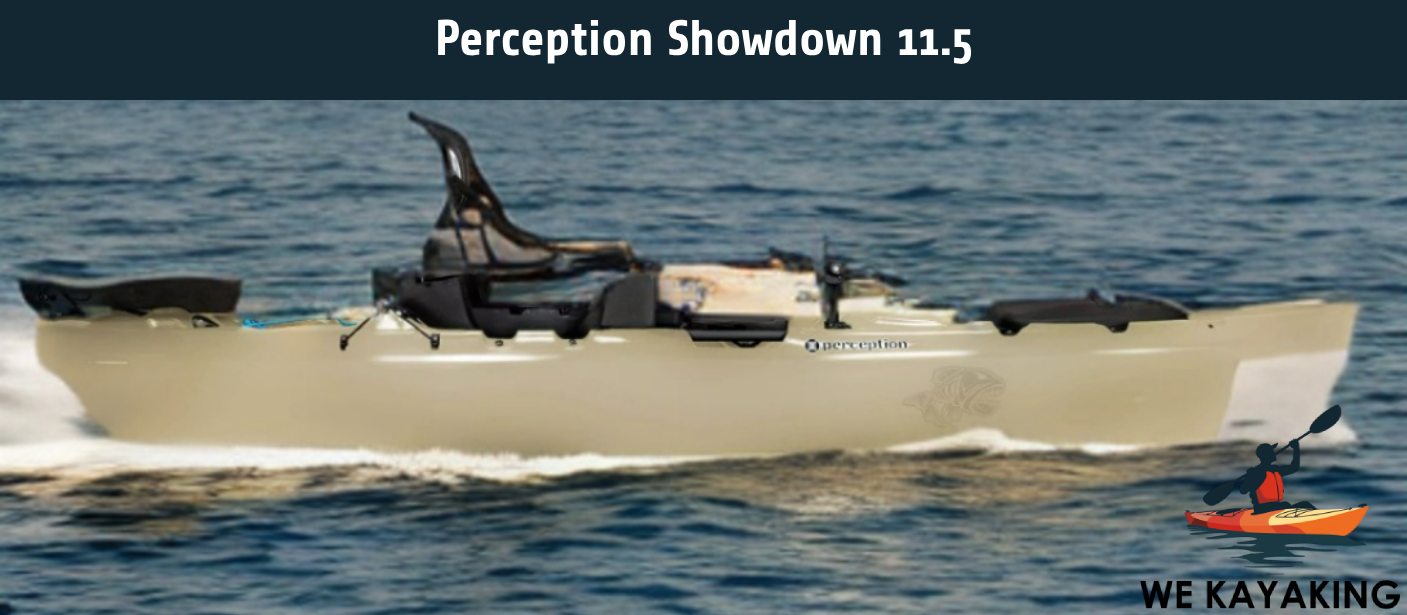 The Perception Showdown 11.5 is a pedal-driven kayak that combines performance, stability, and comfort in a versatile package. It features a rotational pedal system that offers efficient propulsion, allowing for hands-free navigation. The kayak’s hull design ensures excellent tracking, keeping it on course even in choppy conditions. Stability is a key attribute, with a wide beam providing a secure platform for fishing or photography. The Showdown 11.5 boasts impressive speed for its size, making it a great choice for both leisurely paddles and more adventurous outings. At 11.5 feet in length and a generous width, it offers a great balance between maneuverability and stability. Despite its larger size, it remains relatively easy to handle, both on and off the water.
The Perception Showdown 11.5 is a pedal-driven kayak that combines performance, stability, and comfort in a versatile package. It features a rotational pedal system that offers efficient propulsion, allowing for hands-free navigation. The kayak’s hull design ensures excellent tracking, keeping it on course even in choppy conditions. Stability is a key attribute, with a wide beam providing a secure platform for fishing or photography. The Showdown 11.5 boasts impressive speed for its size, making it a great choice for both leisurely paddles and more adventurous outings. At 11.5 feet in length and a generous width, it offers a great balance between maneuverability and stability. Despite its larger size, it remains relatively easy to handle, both on and off the water.
The kayak’s weight is a consideration, but it’s in line with its size and capabilities. Comfort is prioritized with an adjustable seat and ample legroom, catering to a variety of body types. Its durability is ensured by high-quality materials, designed to withstand the rigors of frequent use. Safety features include a stable design and strategic buoyancy. Extra storage is ample, accommodating gear for day trips or longer excursions. Perception Kayaks, known for their quality and innovation, stands behind the Showdown 11.5. The price reflects its premium features and build quality, positioning it as a mid to high-range option in the pedal kayak market.
Advantages of Perception Showdown 11.5 are listed below.
- It has hands free operation due to the efficient rotational pedal system, enhancing the user’s ability to multitask.
- Excellent tracking and stability, offering confidence to users in various water conditions.
- Impressive speed and maneuverability for its size, allowing for a wide range of activities.
- High comfort level with an adjustable seat and spacious design, making long trips more enjoyable.
- Durable construction with high-quality materials ensures longevity and resistance to wear and tear.
- There is ample storage for gear, making it suitable for extended trips or fishing expeditions.
Disadvantages of Perception Showdown 11.5 are listed below.
- The weight of the kayak makes transportation and handling challenging for some users.
- Higher price point, reflecting its advanced features and quality but potentially limiting accessibility for budget-conscious buyers.
- Maintenance requirements for the pedal system, are more complex than those for a traditional paddle kayak.
- Size and width limit its use in extremely narrow or shallow waters where tighter maneuverability is required.
| Feature | Details |
| Weight Capacity | 350 lbs/158.7 kgs |
| Kayaker Position | On Top (sit-on-top) |
| Amount of Riders | Solo |
| Body Type | Accommodates a wide range with adjustable seating and ample legroom |
3. Old Town Canoe Sportsman 120
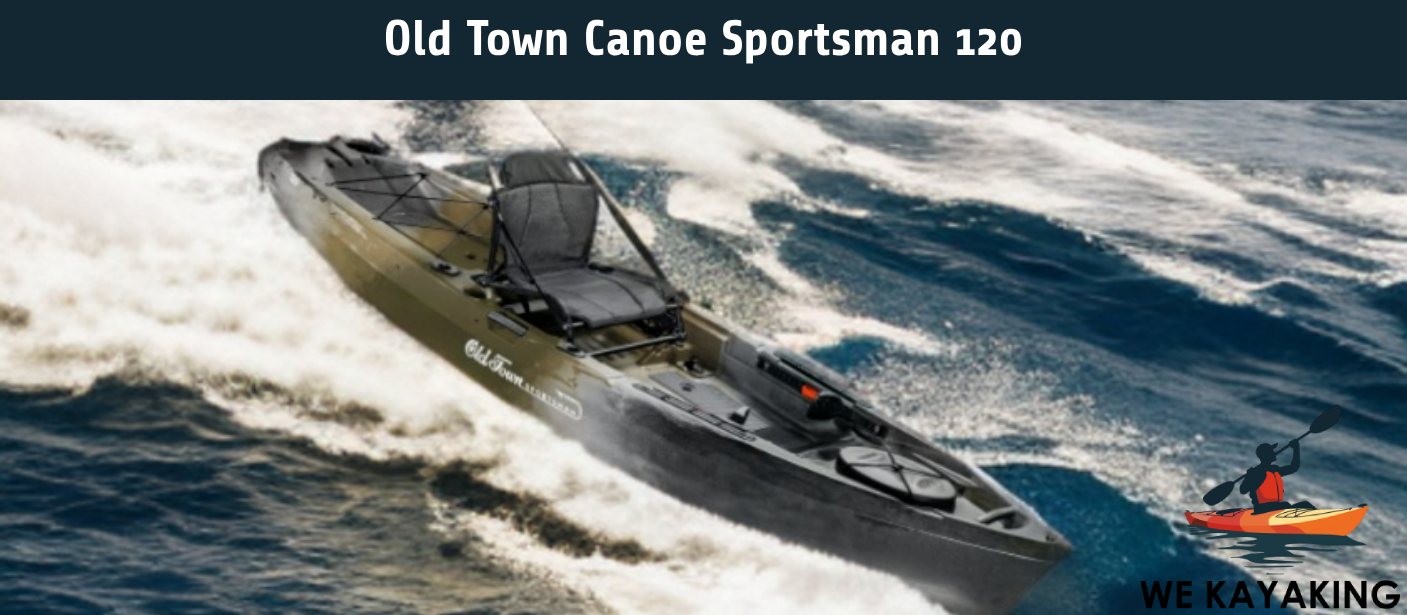 The Old Town Canoe Sportsman 120 is a pedal-driven kayak acclaimed for its exceptional blend of stability, performance, and fishing-specific features. It employs a high-quality rotational pedal system that provides efficient and hands-free propulsion, allowing for precise control and ease of navigation. The kayak showcases excellent tracking capabilities, ensuring it maintains a straight path in various water conditions. Its design focuses on stability, making it a reliable platform for anglers and recreational kayakers alike.
The Old Town Canoe Sportsman 120 is a pedal-driven kayak acclaimed for its exceptional blend of stability, performance, and fishing-specific features. It employs a high-quality rotational pedal system that provides efficient and hands-free propulsion, allowing for precise control and ease of navigation. The kayak showcases excellent tracking capabilities, ensuring it maintains a straight path in various water conditions. Its design focuses on stability, making it a reliable platform for anglers and recreational kayakers alike.
The Sportsman 120 is notable for its speed, enabling quick movement across water bodies. Measuring 12 feet in length and 34 inches in width, it strikes a balance between speed and stability, with ample space for maneuvering. Despite its robust build, it remains relatively maneuverable in different aquatic environments. The kayak weighs around 87 pounds, a consideration for transport and handling. Comfort is a standout feature, with an adjustable and ergonomic seat and well-thought-out cockpit layout. Durability is assured through its high-quality polyethylene construction, designed to withstand the challenges of frequent use. Safety is enhanced by its stable design and reflective detailing. The Sportsman 120 includes generous storage options, catering to the needs of anglers and long-haul kayakers. Old Town Canoe is a reputable brand known for its quality and innovation, and the Sportsman 120 reflects this legacy. The price point is in the higher range, commensurate with its advanced features and build quality.
Advantages of Old Town Canoe Sportsman 120 are listed below.
- The Sportsman 120’s rotational pedal system stands out for offering an efficient and intuitive means of propulsion, allowing kayakers to navigate with minimal effort while keeping their hands free for fishing or photography. This system makes the kayak ideal for those who value the convenience of pedal-driven movement.
- Its design provides exceptional stability, making it a solid platform for anglers who stand up to cast lines or navigate through choppy waters. The kayak’s excellent tracking ensures it maintains a straight course, enhancing the paddling experience by reducing the need to constantly correct direction.
- Despite its stable and robust build, the Sportsman 120 does not sacrifice speed. Its streamlined shape and efficient pedal system allow for quick traversing of water bodies, making it suitable for both leisurely paddles and more ambitious fishing expeditions.
- The adjustable and ergonomically designed seat, along with a spacious cockpit layout, ensures maximum comfort during long hours on the water. This focus on comfort makes the kayak suitable for extended trips and significantly enhances the overall kayaking experience.
- Constructed from high-quality polyethylene, the Sportsman 120 is built to withstand the wear and tear of frequent use in various water conditions, from calm lakes to coastal waters, ensuring a long-lasting investment.
- The kayak is equipped with numerous fishing-specific features and ample storage options, including rod holders, tackle storage, and large tank wells, making it the kayak of choice for serious anglers and those who embark on longer adventures.
Disadvantages of Old Town Canoe Sportsman 120 are listed below.
- Weighing around 87 pounds, the Sportsman 120 is cumbersome for individuals to transport and launch on their own, potentially requiring additional equipment or assistance, especially for those who frequently kayak in remote locations.
- The premium features and quality of the Sportsman 120 come at a higher price point, which does not fit within every budget. This investment is considerable for casual kayakers or those new to the sport, making it more suitable for serious enthusiasts or professional anglers.
- The kayak’s size and weight, while beneficial for stability and storage, hinder its performance in extremely narrow or shallow environments where lighter and more agile kayaks would be more effective, potentially limiting its versatility in certain kayaking conditions.
| Feature | Details |
| Weight Capacity | 500 lbs/226.7 kgs |
| Kayaker Position | On Top (sit-on-top) |
| Amount of Riders | Solo |
| Body Type | Adjustable seating caters to a wide range of body types, ensuring comfort for various users |
4. Perception Pescador Pilot 12
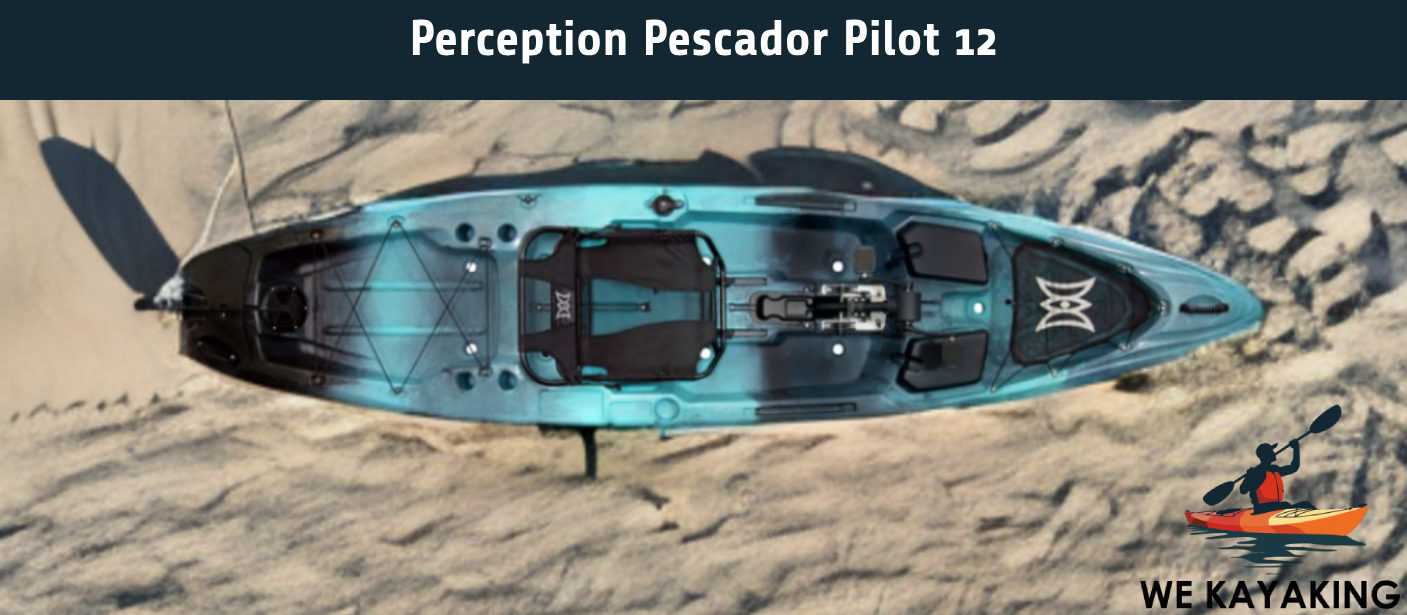 The Perception Pescador Pilot 12 is a pedal-driven kayak designed with anglers and outdoor enthusiasts in mind. It features a rotational pedal system that allows for smooth and efficient movement in the water, providing hands-free propulsion. The kayak is well-regarded for its excellent tracking, ensuring it maintains a straight course even in challenging conditions. Stability is a key strength, with a wide hull design offering a secure platform for fishing or leisure activities.
The Perception Pescador Pilot 12 is a pedal-driven kayak designed with anglers and outdoor enthusiasts in mind. It features a rotational pedal system that allows for smooth and efficient movement in the water, providing hands-free propulsion. The kayak is well-regarded for its excellent tracking, ensuring it maintains a straight course even in challenging conditions. Stability is a key strength, with a wide hull design offering a secure platform for fishing or leisure activities.
The Pescador Pilot 12 boasts commendable speed, making it suitable for covering larger distances. At 12 feet in length and 33.75 inches in width, it balances maneuverability with ample space for gear and movement. Weighing approximately 85 pounds, it is relatively easy to handle on and off the water, given its size. Comfort is enhanced by an ergonomic, adjustable seat and well-designed cockpit. Durability is assured with high-quality construction materials, built to withstand the demands of frequent use. Safety features include a stable design and strategic buoyancy. The kayak offers generous storage options for gear and provisions. Perception Kayaks is known for producing reliable and innovative products, and the Pescador Pilot 12 is no exception. The price point reflects its premium features and quality, positioning it as a mid-range option in the pedal kayak market.
Advantages of Perception Pescador Pilot 12 are listed below.
- The kayak’s rotational pedal system not only provides an efficient means of propulsion but also allows anglers and enthusiasts to engage in activities like fishing, photography, or simply enjoying a beverage, all while on the move.
- With its well-designed hull, the Pescador Pilot 12 maintains excellent tracking, allowing for straightforward navigation even in challenging water conditions. The kayak’s width and hull shape contribute to its outstanding stability, offering a secure and reassuring platform for standing and casting.
- Despite its relatively large size, the kayak is designed to offer good speed and maneuverability, making it a versatile choice for exploring different waterways and effectively reaching fishing spots.
- The adjustable, ergonomically designed seating system ensures that long hours spent on the water are comfortable, reducing the risk of discomfort and fatigue.
- Constructed with high-quality materials, the Pescador Pilot 12 is designed to endure the rigors of regular use, offering durability and resistance to impact and wear.
- The kayak boasts generous storage options, including compartments and gear tracks, well-suited for anglers and adventurers who need to carry various equipment and supplies.
Disadvantages of Perception Pescador Pilot 12 are listed below.
- Weighing around 85 pounds, the kayak poses difficulties in terms of transport and launching, particularly for individuals who embark on solo trips. This factor requires additional equipment or assistance to manage effectively.
- Positioned as a mid-range kayak, the Pescador Pilot 12’s price point, while reflective of its features and quality, necessitates careful consideration for those adhering to a strict budget.
- Given its dimensions, the kayak is not the optimal choice for navigating through extremely narrow or shallow areas, where smaller and more agile kayaks would excel.
| Feature | Details |
| Weight Capacity | 475 lbs/215.456 kgs |
| Kayaker Position | On Top (sit-on-top) |
| Amount of Riders | Solo |
| Body Type | Accommodates a wide range, with adjustable seating for various user comforts |
5. BKC PK14
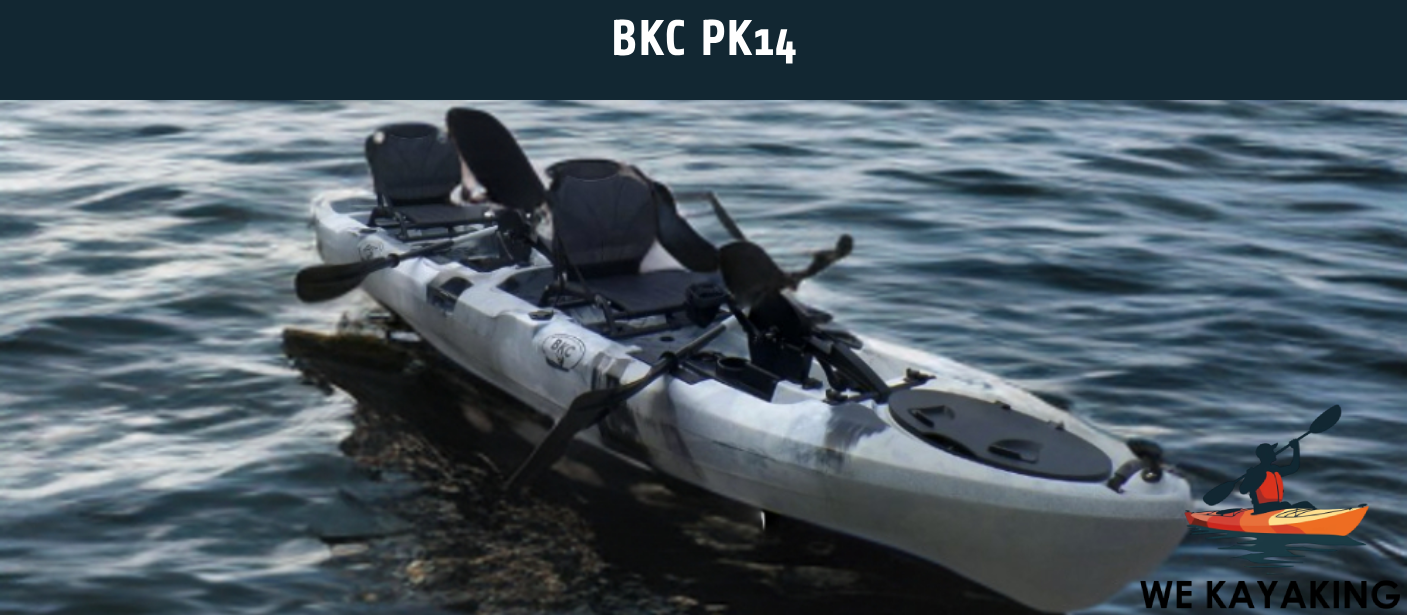 The BKC PK14 is a tandem pedal kayak that stands out for its exceptional stability, spacious design, and dual pedal drive system. Each seat is equipped with its own rotational pedal system, allowing for efficient, hands-free propulsion and teamwork. This kayak showcases excellent tracking, keeping it on a straight course even in challenging waters. Its stability is noteworthy, making it an ideal platform for fishing, photography, or leisurely paddles with a partner.
The BKC PK14 is a tandem pedal kayak that stands out for its exceptional stability, spacious design, and dual pedal drive system. Each seat is equipped with its own rotational pedal system, allowing for efficient, hands-free propulsion and teamwork. This kayak showcases excellent tracking, keeping it on a straight course even in challenging waters. Its stability is noteworthy, making it an ideal platform for fishing, photography, or leisurely paddles with a partner.
The PK14’s speed is impressive for a tandem kayak, benefiting from the combined power of two paddlers. Measuring 14 feet in length and 34 inches in width, it balances speed with stability, providing a comfortable ride. Maneuverability is good for its size, though tight turns in narrow spaces require coordination. The kayak’s weight is crucial due to its size and features, making transport and handling a consideration. Comfort is a highlight, with ergonomic seating and ample space for both kayakers. It’s built for durability, using high-quality materials capable of withstanding frequent use. Safety is enhanced by its stable design and adequate buoyancy. Storage is generous, accommodating gear for both riders. The BKC brand is known for quality and innovation, and the PK14 reflects this reputation. Its price is in the higher range, reflecting its tandem design and premium features.
Advantages of BKC PK14 are listed below.
- It offers efficient propulsion, making long distances easier to cover and allowing for a unique tandem kayaking experience where both kayakers contribute to the movement.
- The wide and well-designed hull provides outstanding stability, making it suitable for various activities, including fishing, where stability is crucial.
- There is ample space for two kayakers, with comfortable seating ensuring an enjoyable journey, even on longer trips.
- Constructed with quality materials, the PK14 is built to last, offering resilience against wear and tear.
- It provides plenty of storage options for gear, making it ideal for extended adventures or fishing expeditions.
Disadvantages of BKC PK14 are listed below.
- Its considerable weight and size pose challenges in transportation and storage, requiring a suitable vehicle or trailer and additional manpower or equipment to handle.
- Reflecting its tandem design and advanced features, the PK14’s price is a significant investment, especially for casual kayakers.
- While it handles well for its size, navigating through very narrow or shallow areas requires more effort and coordination between kayakers.
- The kayak’s length and tandem nature complicate docking and launching, especially in less accessible or confined areas. This limits the locations where the PK14 is able to easily and safely be put into or taken out of the water.
| Feature | Details |
| Weight Capacity | 670 lbs |
| Kayaker Position | On Top (sit-on-top) |
| Amount of Riders | 2 (Tandem) |
| Body Type | Accommodates a wide range of body types, with adjustable seating for comfort |
6. Pelican Getaway 110 HDII
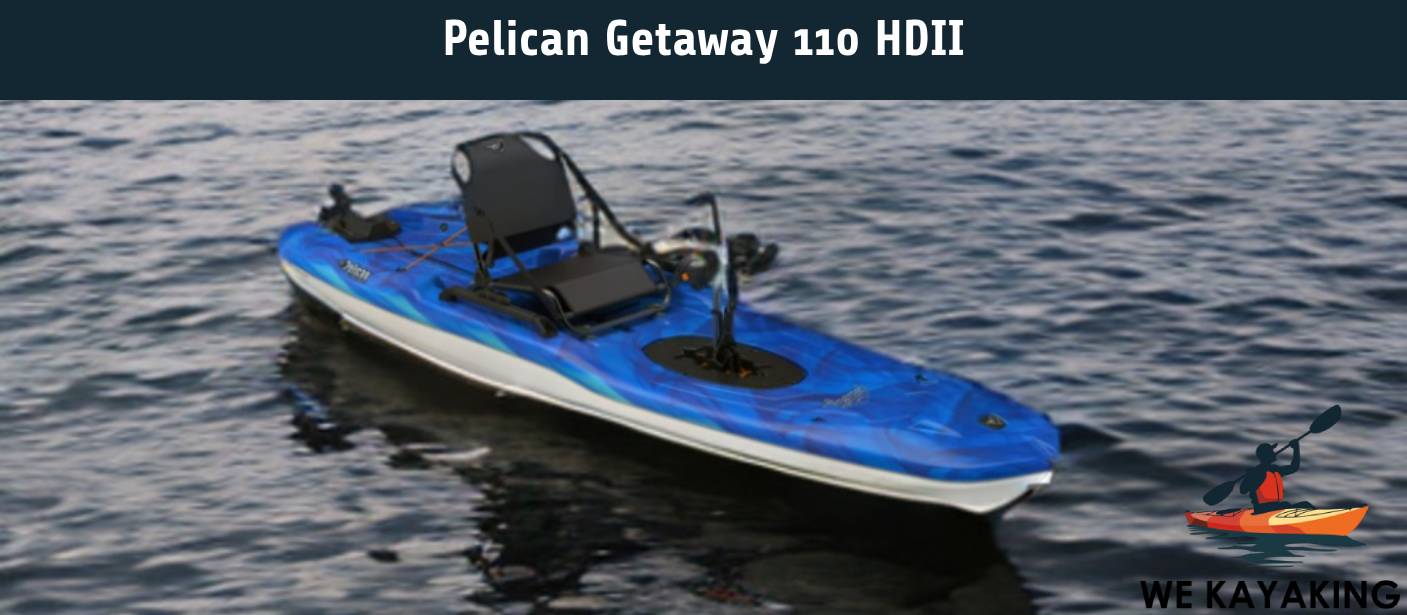 The Pelican Getaway 110 HDII is a solo pedal kayak that features a lightweight, efficient design with a focus on stability and comfort. It utilizes a push pedal system, which propels the kayak forward through a stepping motion, offering an intuitive and easy-to-use mechanism for all skill levels. The kayak exhibits excellent tracking, maintaining a straight path effortlessly. Its design prioritizes stability, making it a reliable choice for recreational paddling and fishing.
The Pelican Getaway 110 HDII is a solo pedal kayak that features a lightweight, efficient design with a focus on stability and comfort. It utilizes a push pedal system, which propels the kayak forward through a stepping motion, offering an intuitive and easy-to-use mechanism for all skill levels. The kayak exhibits excellent tracking, maintaining a straight path effortlessly. Its design prioritizes stability, making it a reliable choice for recreational paddling and fishing.
The Getaway 110 HDII is agile, with a moderate speed that’s suitable for leisurely explorations and short to medium-distance trips. At 10.6 feet in length and 34 inches in width, it combines maneuverability with sufficient space for comfort and storage. Weighing approximately 62 pounds, it’s relatively easy to transport and handle. Comfort is enhanced by an ergonomic, adjustable seat and ample legroom. Durability is ensured by high-quality, impact-resistant materials. Safety features include a stable design and good buoyancy. The kayak offers generous storage options, accommodating gear and personal items. Pelican is known for creating accessible, reliable kayaks, and the Getaway 110 HDII is competitively priced, reflecting its features and quality.
Advantages of Pelican Getaway 110 HDII are listed below.
- It is easy for beginners to use, offering an effective means of propulsion without the learning curve of rotational systems.
- The wide hull design ensures high stability, suitable for fishing or leisurely paddles in various water conditions.
- At 62 pounds, it’s easier to transport and handle than many other pedal kayaks, making it a good option for solo kayakers.
- The adjustable seating and spacious design contribute to a comfortable paddling experience, even during extended use.
- Built with Pelican’s renowned high-impact-resistant materials, ensuring longevity and resilience.
- Well-designed storage compartments accommodate a range of gear and essentials for day trips.
Disadvantages of Pelican Getaway 110 HDII are listed below.
- While efficient, the push pedal system and kayak design prioritize stability and comfort over high speed, which do not satisfy speed enthusiasts.
- The stepping motion of the push pedal system is not as efficient as that of a rotational system in covering long distances or in strong currents.
- Its length and width, while contributing to stability, limit agility in narrow or cluttered environments.
- The price point is a consideration for casual kayakers or those on a tight budget.
| Feature | Details |
| Weight Capacity | 300 lbs |
| Kayaker Position | On Top (sit-on-top) |
| Amount of Riders | Solo |
| Body Type | Accommodates a range of body types with adjustable seating for comfort |
7. Pelican Catch Mode 110
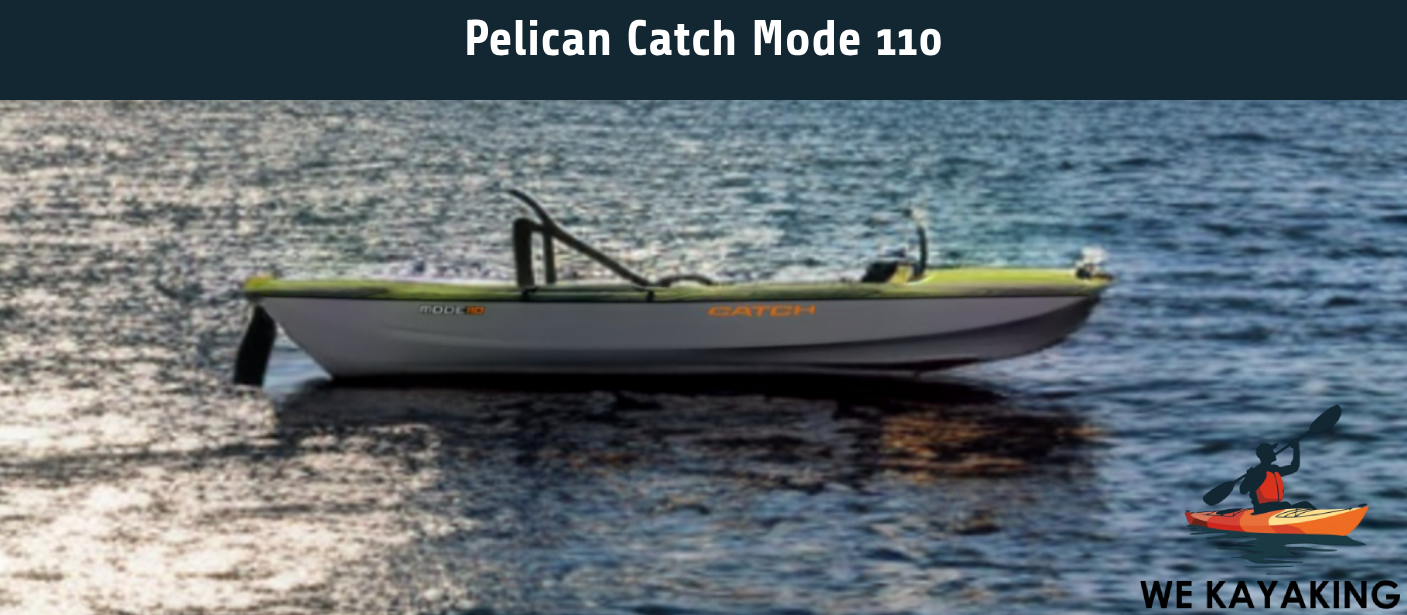 The Pelican Catch Mode 110 is a pedal-driven kayak designed to offer an optimal balance of performance and comfort for fishing and recreational use. It features a rotational pedal system that allows for smooth, efficient movement through the water, akin to cycling. The kayak excels in tracking, ensuring it maintains a straight course with minimal effort. Stability is a key feature, with a wide hull design that provides a secure platform, ideal for fishing or leisure activities.
The Pelican Catch Mode 110 is a pedal-driven kayak designed to offer an optimal balance of performance and comfort for fishing and recreational use. It features a rotational pedal system that allows for smooth, efficient movement through the water, akin to cycling. The kayak excels in tracking, ensuring it maintains a straight course with minimal effort. Stability is a key feature, with a wide hull design that provides a secure platform, ideal for fishing or leisure activities.
The Catch Mode 110 offers good speed, making it suitable for covering distances efficiently. At 10.6 feet in length and 34 inches in width, it strikes a balance between maneuverability and stability. The kayak weighs approximately 67 pounds, which is manageable for transport and handling. Comfort is prioritized with an adjustable and ergonomic seat, along with ample legroom. Durability is ensured through the use of high-quality, impact-resistant materials. Safety features include the kayak’s stable design and good buoyancy. It also offers generous storage options for gear and personal items. Pelican is known for producing accessible and reliable kayaks, and the Catch Mode 110 is competitively priced within the market.
Advantages of Pelican Catch Mode 110 are listed below.
- It mimics the motion of cycling, providing an intuitive and natural way to propel the kayak, suitable for long distances.
- The wide hull design ensures excellent stability, making it a great platform for fishing or enjoying a relaxed paddle.
- The ergonomic seat and layout are designed for comfort during extended use, making it ideal for longer excursions.
- Constructed with Pelican’s high-impact-resistant materials, offering longevity and resistance to wear and tear.
- Provides plenty of space for fishing gear, personal items, and more, catering to the needs of anglers and adventurers.
Disadvantages of Pelican Catch Mode 110 are listed below.
- Weighing in at 67 pounds, it requires effort to transport and launch, especially for solo paddlers.
- While its size contributes to stability, it limits agility in narrow or cluttered waterways.
- The price, while offering good value for its features, is considered high by moderate kayakers or those on a budget.
- The rotational pedal system requires regular maintenance to ensure smooth operation, which could be a consideration for those seeking a low-maintenance kayak.
| Feature | Details |
| Weight Capacity | 350 lbs |
| Kayaker Position | On Top (sit-on-top) |
| Amount of Riders | Solo |
| Body Type | Suitable for a wide range of body types with adjustable seating for personalized comfort |
8. Pelican Sentinel 100X Angler
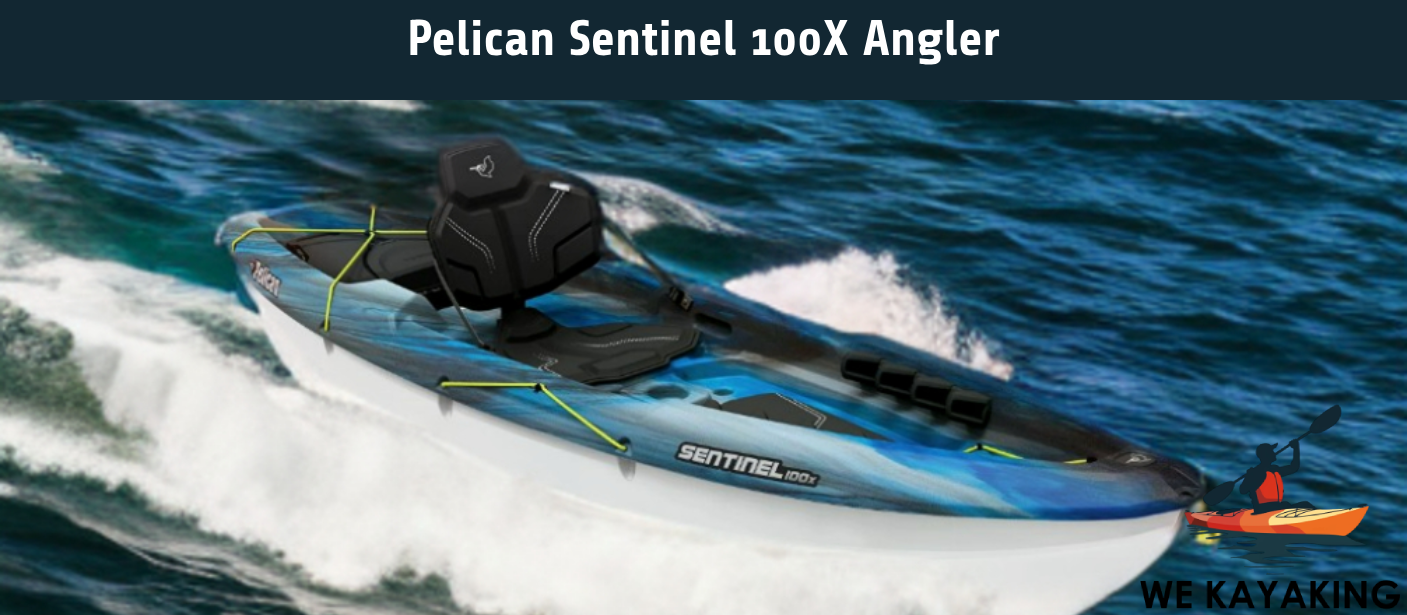 The Pelican Sentinel 100X Angler is a paddle kayak specifically designed for fishing enthusiasts. It stands out for its exceptional stability, lightweight design, and user-friendly features that cater to both beginners and experienced kayakers. The kayak doesn’t incorporate a pedal system, relying instead on traditional paddling, which allows for a more intimate water experience. It boasts impressive tracking for its size, aided by a well-designed hull that ensures a straight path through the water.
The Pelican Sentinel 100X Angler is a paddle kayak specifically designed for fishing enthusiasts. It stands out for its exceptional stability, lightweight design, and user-friendly features that cater to both beginners and experienced kayakers. The kayak doesn’t incorporate a pedal system, relying instead on traditional paddling, which allows for a more intimate water experience. It boasts impressive tracking for its size, aided by a well-designed hull that ensures a straight path through the water.
The Sentinel 100X Angler’s stability is a highlight, with a wide and flat bottom that provides a solid platform for casting and reeling in fish. Speed is moderate, suitable for leisurely excursions and fishing in calm waters. At 9.6 feet in length and 30 inches in width, it combines maneuverability with sufficient space for comfort. Weighing approximately 44 pounds, it is relatively easy to transport and handle. The kayak is built with high-density polyethylene, ensuring durability and resistance to impacts. Comfort is prioritized with an adjustable backrest and molded footrests, accommodating various body types. Safety features are inherent in its stable design, and extra storage compartments are available for gear and catches. Pelican is a reputable brand known for quality and affordability, and the Sentinel 100X Angler offers excellent value for its price point.
Advantages of Pelican Sentinel 100X Angler are listed below.
- The Pelican Sentinel 100X Angler’s wide and flat hull design offers exceptional stability, making it a reliable platform for fishing activities. This stability is crucial for anglers who shift positions or stand up to cast and reel in fish, ensuring safety and confidence even in choppy waters.
- Weighing in at approximately 44 pounds, this kayak is notably lightweight, making it easier for a single person to transport and launch. Its portability is a notable advantage for those who frequently travel to different kayaking spots or need to carry their kayak over some distance from their vehicle to the water.
- Offering a range of fishing-specific features such as rod holders, storage options, and a comfortable seating system at a budget-friendly price point, the Sentinel 100X Angler represents excellent value. This affordability makes it an attractive option for both beginners and seasoned kayakers who are looking for a cost-effective solution without compromising on essential features.
- Constructed from high-density polyethylene, this kayak is built to withstand the rigors of frequent use in various water conditions. Its material provides UV protection, impact resistance, and longevity, ensuring the kayak remains in good condition over time, even with regular exposure to the elements.
Disadvantages of Pelican Sentinel 100X Angler are listed below.
- Designed with stability and maneuverability in mind, the Sentinel 100X Angler offer a different speed than some kayakers desire, especially those looking to cover long distances or paddle in fast-moving waters. Its compact size and wide design prioritize comfort and stability over speed, which limits its use to calm waters and shorter trips.
- As a paddle kayak, it requires manual paddling, which is a drawback for anglers who prefer a hands-free experience to focus entirely on fishing. The absence of a pedal system means that kayakers have to put down their fishing rods to navigate the waters, which could potentially disrupt the fishing experience.
- While it provides adequate storage for day trips, including compartments for personal items and fishing gear, the Sentinel 100X Angler does not meet the needs of those planning longer expeditions or needing to carry more extensive equipment. The storage space is insufficient for multi-day trips or kayakers bringing a wide array of fishing accessories.
| Feature | Details |
| Weight Capacity | 275 lbs/124.7 kgs |
| Kayaker Position | On Top (sit-on-top) |
| Amount of Riders | Solo |
| Body Type | Adjustable seating and footrests cater to a wide range |
What is a pedal kayak?
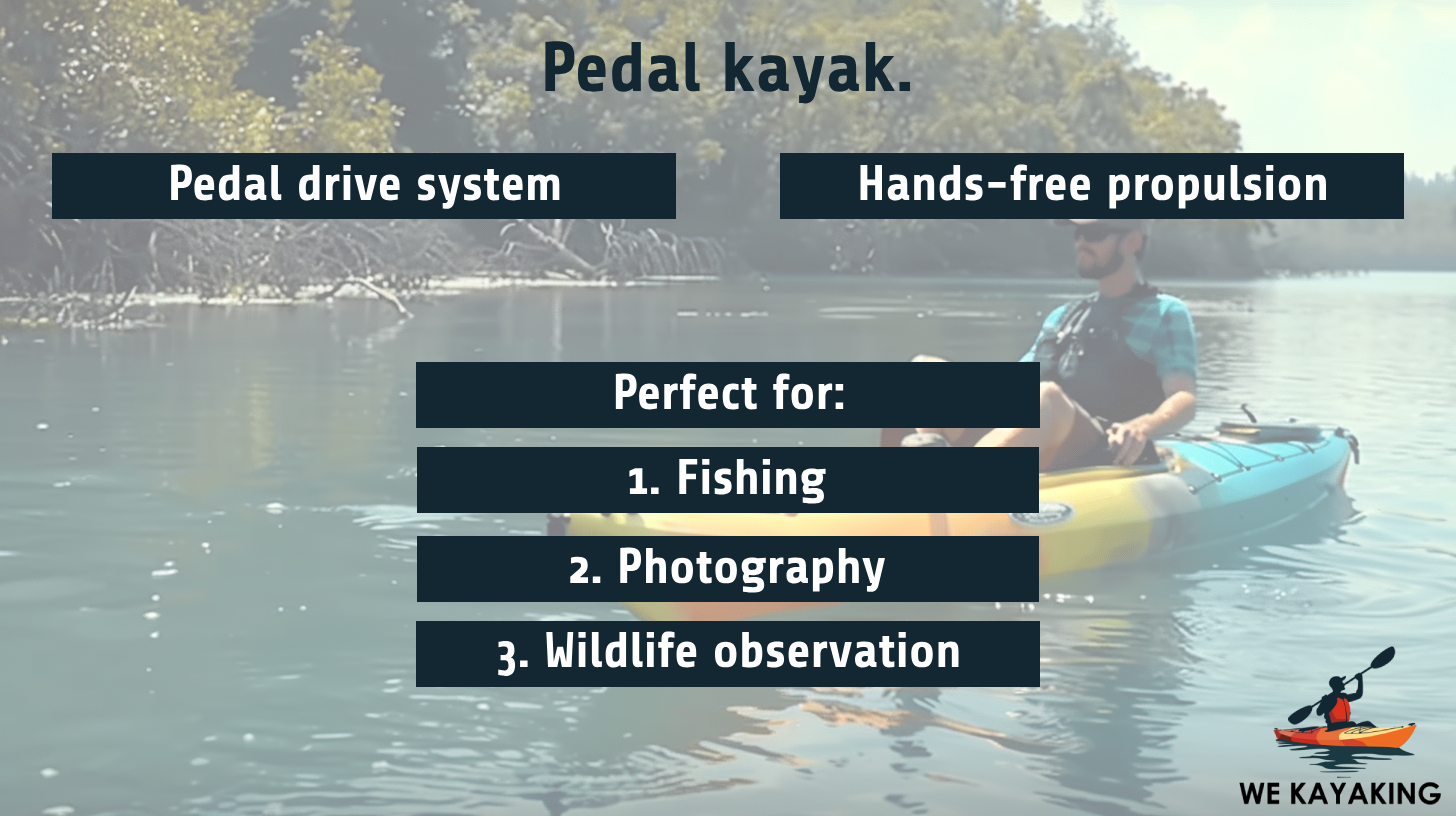 A pedal kayak is a type of kayak that is propelled through the water using a pedal drive system, allowing the kayaker to navigate and move forward using their legs rather than traditional paddling with hands and arms. This hands-free propulsion system offers several advantages, particularly for activities like fishing, photography, or wildlife observation, where having your hands free beneficial. The pedal system in these kayaks come in two main types: push pedals, which move back and forth in a stepping motion, and rotational pedals, which work more like a bicycle, with a circular pedaling motion. Both systems drive a propeller or fins beneath the kayak, providing movement through the water.
A pedal kayak is a type of kayak that is propelled through the water using a pedal drive system, allowing the kayaker to navigate and move forward using their legs rather than traditional paddling with hands and arms. This hands-free propulsion system offers several advantages, particularly for activities like fishing, photography, or wildlife observation, where having your hands free beneficial. The pedal system in these kayaks come in two main types: push pedals, which move back and forth in a stepping motion, and rotational pedals, which work more like a bicycle, with a circular pedaling motion. Both systems drive a propeller or fins beneath the kayak, providing movement through the water.
Pedal kayaks are designed with various features that cater to stability, speed, and maneuverability. They have wider hulls to accommodate the pedal system while ensuring a stable platform, which is particularly advantageous for activities like fishing where the user stands up. Despite their stability, they are also designed to be efficient and fast, with hull shapes that cut through the water with minimal resistance.
In terms of comfort, pedal kayaks are equipped with adjustable seats and footrests to accommodate different body sizes and preferences, ensuring a comfortable experience even during extended use. They also include ample storage space for gear, making them ideal for longer trips or specific activities like fishing and camping. Durability is another key feature, with pedal kayaks made from robust materials that withstand the rigors of frequent use in various water conditions. Safety features, including the kayak’s inherent buoyancy and stability, are integral to the design, providing peace of mind during use.
What sizes of pedal kayaks exist?
Pedal kayaks are available in a variety of sizes to cater to different needs and preferences, ranging from about 10 feet to over 14 feet in length. Compact pedal kayaks, measuring between 10 to 11 feet, are prized for their maneuverability and ease of transport, making them ideal for calm waters, tight spaces, and those who value convenience. These smaller models are particularly suited for short to medium outings and are chosen by recreational kayakers for their agility and ease of handling. Mid-size pedal kayaks, spanning 12 to 13 feet, offer a balanced blend of speed, stability, and maneuverability.
They are versatile enough to perform well in a range of water conditions, from tranquil lakes to more challenging coastal areas, and are favored by both recreational paddlers and anglers who appreciate the mix of performance and practicality. Larger pedal kayaks, extending over 14 feet, are designed for increased stability, speed, and storage capacity, making them suitable for longer expeditions, serious fishing endeavors, and rougher waters. The added length and width provide a stable platform for standing and more room for gear storage, although their size reduce maneuverability in confined spaces. The width of pedal kayaks also varies, ranging from 30 to 36 inches, affecting their stability and room for storage. Wider models tend to offer greater stability and space for equipment, ideal for fishing and extended trips, while narrower kayaks are more streamlined, enhancing speed and efficiency in the water.
What shapes of pedal kayak exist?
Pedal kayaks come in various shapes, each designed to optimize certain aspects of performance such as speed, stability, and maneuverability. The most common shapes include the flat-bottom, pontoon (tunnel hull), and V-shaped hulls. Flat-bottom kayaks are known for their excellent primary stability, making them a popular choice for fishing and recreational use in calm waters, where stability is more crucial than speed. Pontoon hulls, or tunnel hulls, combine elements of flat-bottom and rounded hull designs to offer a balance of stability and efficiency.
These kayaks are stable and perform well in a variety of water conditions, making them versatile for both recreational paddling and fishing. V-shaped hulls are designed to cut through the water more efficiently, offering better speed and secondary stability compared to primary stability. This shape is ideal for more experienced kayakers or those looking to cover longer distances, as it performs well in rougher water conditions but require more skill to balance. Each hull shape has its unique advantages, catering to different kayaking preferences and conditions, allowing paddlers to choose a pedal kayak that best suits their needs and activities.
What materials are pedal kayaks made from?
Pedal kayaks are primarily crafted from either rotomolded polyethylene or thermoformed ABS (Acrylonitrile Butadiene Styrene) plastic. Materials are an important consideration when choosing a pedal kayak, as they affect its durability, weight, and performance.Rotomolded polyethylene stands out for its exceptional toughness and resilience, making it a popular choice for many outdoor enthusiasts. This material is known for its ability to withstand impacts and resist abrasion, which is crucial for navigating through challenging water conditions or coming into contact with rocks and other obstacles. Its construction process involves pouring polyethylene powder into a mold, which is then heated and rotated to evenly coat the interior surfaces, forming a strong, one-piece kayak shell.
Thermoformed ABS plastic is revered for its lighter weight and glossy finish, offering a sleek and aesthetically pleasing appearance. The thermoforming process involves heating a sheet of ABS plastic until it’s pliable, then stretching it over a mold and cooling it to form the desired shape. Kayaks made from this material are easier to carry and maneuver, making them an excellent choice for paddlers who prioritize portability and ease of handling. Additionally, the UV-resistant properties of ABS plastic help maintain the kayak’s color and integrity over time.
What are the most popular brands for pedal kayaks?
When exploring the world of pedal kayaks, certain brands stand out for their innovation, quality, and performance. These manufacturers have earned a reputation among kayaking enthusiasts for offering durable, efficient, and feature-rich pedal kayaks that cater to a variety of preferences and activities. Here are some of the most popular brands known for their exceptional pedal kayaks:
- Pelican is known for crafting a wide range of kayaks, including pedal models like the Catch series, Pelican combines affordability with durability, making their kayaks accessible to a broad audience.
- Perception Kayaks, with models like the Pescador Pilot, is celebrated for offering a blend of performance, comfort, and value, catering to both recreational users and anglers.
- The Sportsman series from Old Town is particularly noted for its pedal kayaks, which are designed with a focus on stability, ease of use, and angler-friendly features.
Is pedal kayak fast?
Yes, pedal kayaks are fast, with the ability to reach speeds of 5 to 8 mph, which is notably faster than traditional paddle kayaks that achieve speeds of 3 to 4 mph. This higher speed is due to the pedal kayaks’ design that allows for more efficient propulsion by leveraging the larger muscle groups in the legs compared to the arms used in paddle kayaks.
Ric Burnley, in his article “Pedal Boat Olympics: Testing The Best Pedal Drive Fishing Kayaks” proposed that, pedal kayaks like the Native Watercraft Manta Ray Propel Angler 12 are designed for speed and efficiency, with features such as a sleek hull design and a durable, innovative pedal system. The Propel Pedal Drive system, for example, has been refined over the years to be more efficient, lighter, and quieter, contributing to the kayak’s speed on the water.
The article by Colin Angus titled “A Speed Comparison of Kayaks, Rowboats, Canoes, SUPS and Pedal Boats” articulated that pedal power has demonstrated its superiority in human-powered watercraft, holding records for both short and long distances on flat water. The Decavitator, a pedal-powered hydrofoil, holds the world record for the fastest 100-meter sprint on water, averaging 18.5 knots, showcasing the potential speed of pedal-driven designs.
According to the article, “How Fast Can You Go on a Pedal Kayak? & How to Make It Go Faster” by Toby Adriel, it’s important to note that the actual speed of a pedal kayak varies based on factors like kayak design, water and weather conditions, and the paddler’s physical ability and technique. Longer and narrower kayaks with lightweight materials tend to be faster, and paddlers with better technique and physical fitness achieve higher speeds.
Is pedal kayak safe?
Yes, pedal kayaks are safe when used properly and maintained well. They’re particularly user-friendly for beginners and offer hands-free operation, which is more comfortable and less tiring than traditional kayaks. According to a piece by killerkayaks.com titled “Are Pedal Kayaks Safe?” key safety practices include wearing a personal flotation device, checking weather conditions before heading out, and informing someone about your kayaking plans. Pedal kayaks also tend to be stable and are able to be equipped with a rudder system for better control.
Can a pedal kayak withstand strong waves?
According to an article by killerkayaks.com titled “Are Pedal Kayaks Safe?” yes, pedal kayaks are able to withstand strong waves, particularly those designed for stability and equipped with a rudder system for improved control. However, their performance in rough waters will depend on the specific design and build of the kayak, as well as the skill level of the kayaker. It’s important to choose a pedal kayak suited to your intended use and to practice good safety measures.
Is pedal kayak cold temperature resistant?
Yes, pedal kayaks are designed to be resistant to cold temperatures. The materials used in their construction, such as high-density polyethylene, and the engineering of their mechanical components, like pedal drives, are made to endure various weather conditions, including the cold. These kayaks are equipped with features like the MirageDrive 360 system found in the Hobie Mirage Pro Angler 12, which includes kick-up fins and a rudder designed to retract upon impact, ensuring durability and functionality in different environments.
Maintenance is crucial, especially in colder climates, to ensure the pedal system continues to operate efficiently. Regular inspections and proper care, as advised by manufacturers, help maintain the kayak’s performance in cold temperatures. It’s also important to consider personal safety measures when kayaking in cold water to prevent hypothermia, as the kayak’s cold temperature resistance doesn’t extend to protecting the user from the cold water’s effects.
Can you store a pedal kayak outside?
Yes, you are able to store a pedal kayak outside, but it requires specific precautions to protect it from weather elements, potential damage, and theft. Firstly, finding a suitable spot that offers some protection from direct sunlight, rain, and snow is crucial because prolonged exposure harms the kayak’s material and structure. A sheltered location, such as under a deck or a covered patio, is ideal to prevent UV damage from the sun, which degrades almost any hull material.
Steve Morrow’s article titled “Master The Art Of Storing A Kayak Outside” stipulates that before storing the kayak, it’s essential to clean it thoroughly to remove dirt, salt, or grime, and let it dry completely to prevent mold and mildew growth. Using a high-quality kayak cover or a waterproof tarp offer additional protection, but make sure it’s secured properly to prevent moisture accumulation.
Sophie Thompson’s article, “How to Store a Kayak Outside,” suggests elevating the kayak off the ground on a rack or stand to prevent damage from damp surfaces and make it less accessible to pests and rodents. It’s also important to distribute the weight evenly to avoid deforming the hull and to secure the kayak properly to protect it from strong winds and potential theft.
Can pedal kayak withstand crashing into river rocks?
Yes, pedal kayaks are able to withstand crashing into river rocks, given proper caution.
According to Madison Wilson’s article, “Pros and Cons of Pedal Kayaks: An In-Depth Look,” pedal kayaks are designed with durability in mind, including features such as increased legroom, enhanced stability, and the ability to handle various water conditions. This makes them suitable for a wide range of activities, from fishing to recreational paddling, and they offer the convenience of hands-free operation, allowing for more efficient use of the kayaker’s strength through the legs. However, when it comes to the specific question of whether a pedal kayak withstands crashing into river rocks, the situation is more nuanced.
“Handling Rocks,” an article by Ken Whiting, recommends that while pedal kayaks are durable and handle various water conditions, it’s essential to approach obstacles like river rocks with caution. The construction of pedal kayaks, especially those made from materials like rotomolded polyethylene, provides a certain level of resistance to impacts and abrasions. Yet, no kayak is entirely impervious to damage. When colliding with a rock, the key is to minimize the impact to avoid damaging the kayak or injuring yourself. If avoiding the rock is not possible, it’s crucial to approach it in a way that lessens the chance of flipping or causing major damage, such as by keeping the boat tilted downstream to prevent the upstream edge from catching the current.
Can a pedal kayak withstand a crocodile bite?
No, a pedal kayak isn’t able to withstand a crocodile bite. According to Romero Esposito’s findings titled “How Scientists Measure The Biting Power Of Crocodiles,” crocodiles possess one of the strongest bite forces in the animal kingdom, capable of exerting tremendous pressure that easily crushes bone. This force is far beyond what a pedal kayak, which is usually made from plastic materials like polyethylene, are able to withstand. Although these kayaks are designed to be durable and handle bumps and scrapes against rocks or submerged objects, they are not built to resist the sheer force of a crocodile’s bite.
Materials used in kayak construction, such as high-density polyethylene (HDPE), are chosen for their balance between flexibility, durability, and weight, making them suitable for water activities. However, they are not indestructible and certainly not designed to endure the extreme pressures exerted by wildlife such as crocodiles. A crocodile’s jaws could easily puncture and severely damage a kayak, posing high risks to the occupant.
Is pedal kayak stable?
Yes, pedal kayaks are considered stable. Pedal kayaks are widely regarded for their stability, which is attributed to their design and construction features. These kayaks have wider hulls, offering a solid base that enhances lateral stability, crucial for activities like fishing or photography where movement on the kayak is common. Some models also boast flat or pontoon hull designs, which further improve stability by providing a strong foundation in both still and choppy waters. The low seating position in pedal kayaks lowers the center of gravity, contributing to the overall steadiness and reducing the likelihood of capsizing.
The pedal drive system, central to these kayaks, not only allows for hands-free operation, making it easier to balance and maneuver but also ensures a smoother propulsion that minimizes rocking. However, it’s important to note that the added weight and the potential vulnerability of the pedal mechanism in shallow waters could pose challenges, requiring careful navigation around underwater obstacles.
Is pedal kayak easy to tip over?
No, pedal kayaks are not easily tipped over. “Do Kayaks Tip Easily? And How to Avoid It?” an article by kayakpapa.com found that the design and stability of kayaks, including pedal kayaks, make them difficult to tip over under normal conditions. Kayaks have a low center of gravity and a wide base, which contributes to their stability on the water. While certain factors like the paddler’s movements, water conditions, and the kayak’s design influence stability, pedal kayaks are engineered to be stable and secure, especially for recreational and fishing purposes. Paddlers need to maintain even weight distribution and practice proper paddling techniques to enhance stability further. With some experience and understanding of the kayak’s handling, tipping over becomes less of a concern.
Nazmul Hossin’s article titled “Do Kayaks Tip Over Easily? A Comprehensive Guide” informs us that pedal kayaks are known for their stability, which is a huge advantage for enthusiasts of all levels, from beginners to advanced kayakers. The stability of a kayak, pedal-operated or otherwise, is influenced by several key design factors and user practices. Firstly, the kayak’s hull shape plays a crucial role. Kayaks with wider hulls offer greater primary stability, making them feel more secure on calm waters, which is particularly reassuring for new paddlers. On the other hand, kayaks with a narrower hull and a more pronounced keel offer better secondary stability, which is the stability felt when a kayak is leaned on its side, in rougher waters.
The material and build of a pedal kayak also contribute to its buoyancy and stability. Most are constructed from durable, lightweight materials that help keep the kayak afloat and stable even when navigating through challenging conditions. Additionally, the pedal mechanism in these kayaks allows for hands-free operation, enabling paddlers to maintain a more balanced posture and focus on steering rather than paddling. This leads to a more stable experience, especially in windy conditions or when navigating currents.
Seakayakexplorer.com published an article called “Do Kayaks Tip Over Easily? What You Need to Know and How to Prevent It.” In this piece, it suggests that user skill and confidence play roles in the kayak’s stability as well. As paddlers gain experience, they become more adept at maintaining balance and reacting to the kayak’s movements, further reducing the likelihood of capsizing. Practicing in various conditions helps build this confidence and skill, making even more tippy kayaks feel stable under the control of an experienced kayaker.
How much weight can a pedal kayak hold?
A pedal kayak holds between 250 to 600 pounds (113 to 272 kilograms). Pedal kayaks are designed to accommodate a wide range of weights, catering to various users and their gear needs. The weight capacity of a pedal kayak depends on its design, size, and intended use. Recreational models usually support around 250 to 350 pounds (113 to 158 kilograms), making them suitable for casual paddling and light fishing. These kayaks are great for day trips and exploring calm waters.
Touring or fishing pedal kayaks, known for their stability and storage space, hold between 400 to 600 pounds (181 to 272 kilograms). This higher capacity allows for the inclusion of fishing gear, camping equipment, and other essentials for longer excursions or serious angling adventures.
Is it hard to transport a pedal kayak?
Yes, transporting a pedal kayak is hard. Transporting a pedal kayak is challenging due to its size and weight, but is manageable with the right equipment and techniques. Pedal kayaks are heavier and bulkier than their traditional paddle counterparts, primarily because of the added weight of the pedal drive system and the more robust construction to support this mechanism. This makes them more cumbersome to lift, carry, and load onto a vehicle.
To ease transportation, many kayak enthusiasts use specialized kayak carts that allow you to wheel the kayak from your vehicle to the water. These carts reduce the strain of carrying the kayak, especially over longer distances or rough terrain. For vehicle transport, roof racks or kayak trailers are popular choices. A good roof rack system, equipped with proper straps and padding, secures the kayak atop most vehicles, though the weight of the kayak requires two people to lift it safely. Kayak trailers offer an alternative that eliminates the need to lift the kayak high off the ground, making loading and unloading easier and more accessible for solo adventurers or those with physical limitations.
Is it hard to learn to control a pedal kayak?
No, learning to control a pedal kayak is not hard for most people. Pedal kayaks are designed with user-friendly mechanisms that mimic the motion of cycling, making the learning curve relatively gentle, especially for those who already know how to ride a bike. The pedal system propels the kayak forward or backwards, and steering is managed through a hand operated rudder system. This intuitive design allows for easy maneuverability and control.
For beginners, it takes a short period of adjustment to get used to the coordination between pedaling and steering, especially when navigating through tight spots or making sharp turns. However, most users find that they get comfortable with the basics of pedal kayak control within a few hours of practice. The key advantages of pedal kayaks, such as hands-free operation and the ability to maintain a steady course while fishing or taking photographs, become apparent quickly, enhancing the overall kayaking experience.
Is pedal kayak maneuverable?
Yes, pedal kayaks are maneuverable. According to Steve Morrow’s article “Pedal Kayak vs. Paddle Kayak: How To Choose the Right One, ” these kayaks are designed to provide excellent maneuverability, allowing paddlers to navigate through various water conditions with ease. The incorporation of a pedal system enables users to maintain propulsion while freeing their hands for steering, using a rudder system. This combination of hands-free propulsion and precise steering control makes it easier to maneuver in tight spots, around obstacles, or when angling in specific fishing spots.
Moreover, many pedal kayaks are equipped with rudders or skegs that are adjusted to improve tracking and turning capabilities, further enhancing their maneuverability. Some models even offer reverse pedaling, giving paddlers the ability to back up or adjust their position without needing to use a paddle. This level of control is particularly beneficial in environments where quick changes in direction or position are necessary, such as in narrow waterways or crowded fishing areas.
Is pedal kayak good for beginners?
Yes, pedal kayaks are good for beginners. According to Steve Morrow’s article “Pedal Kayak vs. Paddle Kayak: How To Choose the Right One, ” they offer several advantages such as hands-free operation, which allows for multitasking and makes the kayaking experience less intimidating for novices. Additionally, the pedal mechanism is similar to cycling, a familiar motion for most, which eases the learning curve. However, beginners should be mindful of a pedal kayak’s weight and size when considering transportation and storage.
Is a pedal kayak good for children?
Yes, pedal kayaks are suitable for children, with certain considerations for safety, size, and features tailored to young paddlers. Pedal kayaks offer advantages like increased stability, more legroom, and reduced strain on the back and arms, making the kayaking experience more comfortable and enjoyable. The hands-free operation allows for easier maneuvering and control, which could be particularly beneficial for children who find traditional paddle kayaks challenging.
Mimi McFadden’s article, “11 Best Kayaks for Kids To Get Them Out on the Water at a Young Age,” suggests that when selecting a kayak for children, it’s important to consider specific youth friendly features. Kayaks designed for children, such as the Emotion Sparky Youth Kayak, are lightweight, have molded finger handles for easier grasping, and are narrow to prevent children from knocking their knuckles on the sides. These design elements help to accommodate the physical capabilities of young paddlers, ensuring they effectively control and enjoy their kayaking experience.
Some pedal kayaks, like the BKC PK 13, are designed with features that enhance the kayaking experience. These include ergonomic seats for comfort during long hours on the water, pedal drive systems for efficient movement without paddles, and built-in storage for carrying necessary gear. While these features are primarily aimed at adult users, they indicate the overall advancements in pedal kayak design that contribute to a safe and enjoyable experience for paddlers of all ages, provided the kayak’s size and weight are appropriate for the child.
What is the main purpose of the pedal kayak?
The main purpose of a pedal kayak is to offer a hands-free, efficient, and comfortable kayaking experience, particularly beneficial for activities like fishing, photography, and recreational paddling. Unlike traditional paddle kayaks, pedal kayaks are powered by a foot pedal system connected to fins or a propeller beneath the kayak, allowing for propulsion through leg movements. This setup not only provides greater speed and efficiency but also reduces strain on the back and arms, making it possible to enjoy longer trips on the water with less fatigue.
Pedal kayaks are designed with features that enhance comfort and performance. They offer more legroom and storage capacity, which adds convenience for carrying equipment and personal items. The ergonomic design and increased stability of pedal kayaks also make them suitable for a wider range of water conditions, including shallow waters where traditional paddles are hindered.
The pedal mechanism allows for easy navigation and control, with some models equipped with rudder systems steered via hand controls, further enhancing maneuverability. This makes pedal kayaks an appealing option for both beginners and experienced kayakers looking for a more relaxed kayaking experience or those who wish to focus on activities like fishing, where hands-free operation is a significant advantage.
Can you use a pedal kayak for fishing?
Yes, you are able to use a pedal kayak for fishing. As articulated by Ric Burnley’s article “Best Pedal Kayak: 9 Great Fishing Kayaks That Keep Your Hands Free for Fishing,” pedal kayaks are specifically designed to enhance the fishing experience by providing hands-free operation, which allows anglers to focus on casting and reeling in fish without having to juggle a paddle. The maneuverability and stability offered by pedal systems, such as Hobie’s MirageDrive 360, make them ideal for navigating into tight fishing spots and maintaining position in current and wind, adding significant advantages to the fishing experience.
Mark Armstrong’s report titled “Best Pedal Kayak – 2024 Reviews & Guide For Fishing & Recreation” states that models like the Old Town Sportsman BigWater and Pelican The Catch 130 Hydryve II are examples of pedal kayaks tailored for fishing, with features that cater to the needs of anglers. These kayaks come equipped with ample storage for gear, comfortable seating for long days on the water, and mounts for fishing rods and electronics. The pedal systems in these kayaks are designed for efficiency and ease of use, allowing for forward and reverse propulsion, which is particularly handy when maneuvering in tight spaces or when needing to quickly adjust positions while fishing.
What bodies of water are suitable for a pedal kayak?
Pedal kayaks are versatile and suitable for a wide range of water bodies, making them a great choice for different kayaking experiences. They perform well in calm waters such as lakes and slow-moving rivers, where their stability and hands-free operation are fully utilized for activities like fishing or wildlife photography. The efficiency of pedal drives allows for easier navigation and control, making these kayaks ideal for exploring vast bodies of water without excessive fatigue.
Moreover, pedal kayaks are also capable of handling offshore environments, as some models are specifically designed with features like the Hobie’s Mirage Drive system that enhances maneuverability and control even in rough waters. The design considerations in these kayaks, such as retractable fins and rudder systems, enable them to adapt to varying conditions, from navigating through waves to maintaining position in currents and winds.
However, it’s important to note that while pedal kayaks offer increased versatility, they are not the best choice for extremely shallow waters or areas with heavy underwater vegetation, as the pedal system components are susceptible to damage or entanglement.
What is considered a good price for a pedal kayak?
A good price for a pedal kayak varies widely depending on several factors, including the kayak’s features, brand, and construction quality. Entry level pedal kayaks with basic features start at around $800 to $1,000. These kayaks are suitable for recreational use but lack some advanced features found in more expensive models.
Mid-range pedal kayaks, which offer improved build quality and more features, ranges from approximately $1,200 to $2,000. These kayaks include more comfortable seating, better storage options, and enhanced performance characteristics.
High-end pedal kayaks, particularly those designed for specific activities like fishing or long-distance touring, are considerably more expensive, with prices ranging from $2,000 to $4,000 and even higher. These premium models come equipped with the most advanced pedal drive systems, extensive storage, high quality seats, and are built with durability and performance in mind.
